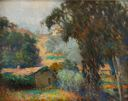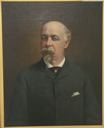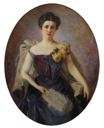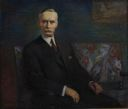John Willard Clawson does not have an image.
John Willard Clawson
(Salt Lake City, Utah, 1858 - 1936, Salt Lake City, Utah)
One of the most successful Utah artists of the late nineteenth century, John Willard Clawson was born on January 18, 1858. He was born to Hiram B. Clawson and Alice Young Clawson, a daughter of Brigham Young, who was then President of the LDS Church. Will (as he was called) was born in the blue room of the Beehive House, the house built by Brigham Young for his wives and their families. As a boy and throughout his life, Will was known for his pleasing personality and his ability to get along with people. Clawson received his education in the Salt Lake City school system and later studied at the University of Deseret under George M. Ottinger. His talent in art was so apparent to his teachers that they encouraged him to go to New York City to study in the best schools. Will's father worked as a businessman and disapproved of art as a profession for his son. He refused to pay for Will's trip to New York. After other people offered to pay for the trip Will's father consented to support him on his trip. In 1881, Clawson and his new bride, Mary Clark, moved to New York City. During his three years in New York, Clawson studied with great success at the National Academy of Design, receiving acclaim and awards from his instructors. After he completed his schooling, Clawson returned with his family to Salt Lake City and opened a private studio. Although he preferred painting landscapes, it soon became clear that most of his money would be made from portraits commissions. In 1891, because of a desire for further study, Clawson left Utah for Paris, France, to enroll in the famed Academie Julian where he studied under such artists as Constant, Laurens, and Lefebvre. In addition, Clawson studied at Fernand Cormon's Atelier and was accepted at the Ecole de Beaux Arts. He was one of a select few who received criticism and instruction from Edouard Manet and Claude Monet. While in Europe, he spent nine months studying under Julius Stewart in Venice and a short time studying in England, where he completed several portraits for members of the English Parliament. The influences of Impressionism are evident in Clawson's works. To portray his subjects, he used warm, bright colors and thickly applied paint combined with a strong knowledge of human anatomy which he had gained from studying cadavers. While he continued to be a financial success throughout his life, Clawson reached his peak as an artist during this time in Europe. Clawson returned to Utah in 1896, where he opened a studio for a few years. During his stay, the Society of Utah Artists was formed and Clawson served as the first secretary. Once again Clawson left Utah, this time for California, where he established a studio in San Francisco. Will Clawson had built a very successful studio and was happy in San Francisco, but in 1906, the San Francisco earthquake and fires destroyed much of the city. Clawson's studio was completely destroyed along with $80,000 worth of paintings. He was forced to start over again and left the ruined city of San Francisco for Los Angeles, then for New York City, and finally, back to Southern California. Clawson's individual style of using fresh colors and glorifying his subjects brought success back to his business. He painted women, showing their grace and beauty, and he painted men with a rugged strength, even if he occasionally had to create it for them. Many famous movie and theater stars in Los Angeles and New York City sought after him to paint their portraits. (SMA Website 4/29/16) By 1933, Clawson had made enough money painting portraits of movie and theater stars to retire to Utah for the remainder of his life. Utah lured Clawson back with her mysterious deserts, far- reaching mountains, and endless skies. He wanted to fulfill a life-long desire to paint landscapes, and he felt Utah offered him the best opportunity. Will always had a love of the outdoors, but having lived most of his life in the big cities, he never had the opportunity to paint the kind of landscapes found in the deserts of Utah. He had only been back in Utah for three years when on April 6, 1936, after having spent a day in his studio working on a portrait of the first Mormon prophet Joseph Smith, he suffered a fatal heart attack and died at the age of 78.
(Salt Lake City, Utah, 1858 - 1936, Salt Lake City, Utah)
One of the most successful Utah artists of the late nineteenth century, John Willard Clawson was born on January 18, 1858. He was born to Hiram B. Clawson and Alice Young Clawson, a daughter of Brigham Young, who was then President of the LDS Church. Will (as he was called) was born in the blue room of the Beehive House, the house built by Brigham Young for his wives and their families. As a boy and throughout his life, Will was known for his pleasing personality and his ability to get along with people. Clawson received his education in the Salt Lake City school system and later studied at the University of Deseret under George M. Ottinger. His talent in art was so apparent to his teachers that they encouraged him to go to New York City to study in the best schools. Will's father worked as a businessman and disapproved of art as a profession for his son. He refused to pay for Will's trip to New York. After other people offered to pay for the trip Will's father consented to support him on his trip. In 1881, Clawson and his new bride, Mary Clark, moved to New York City. During his three years in New York, Clawson studied with great success at the National Academy of Design, receiving acclaim and awards from his instructors. After he completed his schooling, Clawson returned with his family to Salt Lake City and opened a private studio. Although he preferred painting landscapes, it soon became clear that most of his money would be made from portraits commissions. In 1891, because of a desire for further study, Clawson left Utah for Paris, France, to enroll in the famed Academie Julian where he studied under such artists as Constant, Laurens, and Lefebvre. In addition, Clawson studied at Fernand Cormon's Atelier and was accepted at the Ecole de Beaux Arts. He was one of a select few who received criticism and instruction from Edouard Manet and Claude Monet. While in Europe, he spent nine months studying under Julius Stewart in Venice and a short time studying in England, where he completed several portraits for members of the English Parliament. The influences of Impressionism are evident in Clawson's works. To portray his subjects, he used warm, bright colors and thickly applied paint combined with a strong knowledge of human anatomy which he had gained from studying cadavers. While he continued to be a financial success throughout his life, Clawson reached his peak as an artist during this time in Europe. Clawson returned to Utah in 1896, where he opened a studio for a few years. During his stay, the Society of Utah Artists was formed and Clawson served as the first secretary. Once again Clawson left Utah, this time for California, where he established a studio in San Francisco. Will Clawson had built a very successful studio and was happy in San Francisco, but in 1906, the San Francisco earthquake and fires destroyed much of the city. Clawson's studio was completely destroyed along with $80,000 worth of paintings. He was forced to start over again and left the ruined city of San Francisco for Los Angeles, then for New York City, and finally, back to Southern California. Clawson's individual style of using fresh colors and glorifying his subjects brought success back to his business. He painted women, showing their grace and beauty, and he painted men with a rugged strength, even if he occasionally had to create it for them. Many famous movie and theater stars in Los Angeles and New York City sought after him to paint their portraits. (SMA Website 4/29/16) By 1933, Clawson had made enough money painting portraits of movie and theater stars to retire to Utah for the remainder of his life. Utah lured Clawson back with her mysterious deserts, far- reaching mountains, and endless skies. He wanted to fulfill a life-long desire to paint landscapes, and he felt Utah offered him the best opportunity. Will always had a love of the outdoors, but having lived most of his life in the big cities, he never had the opportunity to paint the kind of landscapes found in the deserts of Utah. He had only been back in Utah for three years when on April 6, 1936, after having spent a day in his studio working on a portrait of the first Mormon prophet Joseph Smith, he suffered a fatal heart attack and died at the age of 78.




